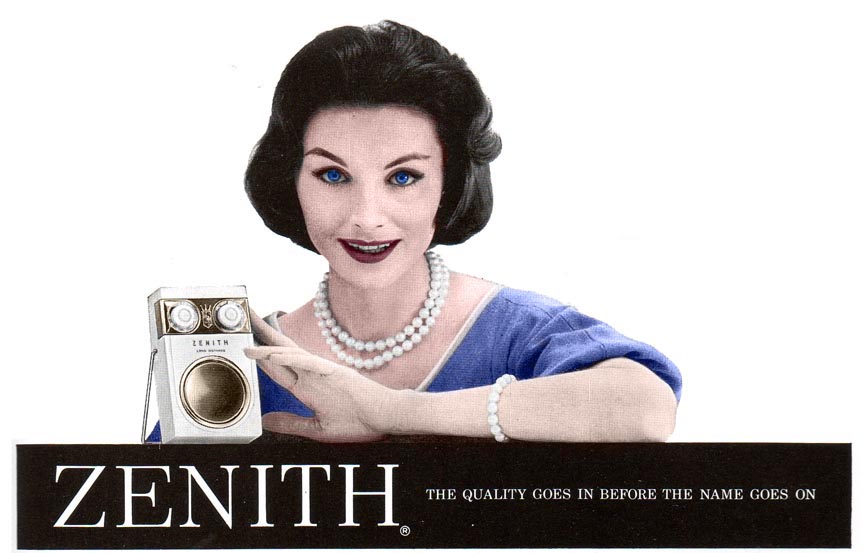

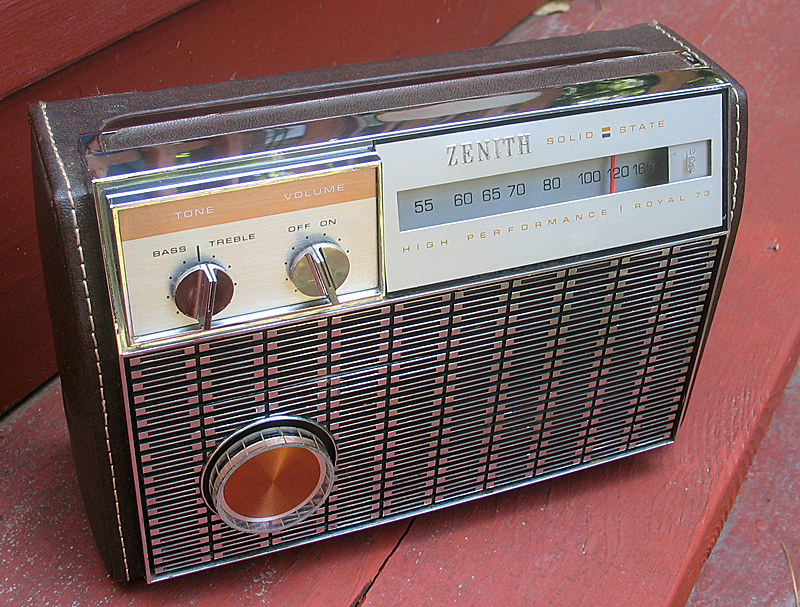 1968 Zenith Royal 73 Transistor Radio
1968 Zenith Royal 73 Transistor Radio
The Zenith Royal R73J is a stylish, excellent performing radio. By 1968, Zenith was sadly no longer making radios in the USA. The Royal 72 was made in Hong Kong. It is of very high quality construction, and with nine transistors and three diodes, a tuned RF circuit, and push-pull output, is a superior example of Zenith craftsman ship.
I found this example on EBay, and purchased it because I wanted a "lefty," a radio with controls, including tuning, on the left-hand side of the radio. Zenith made several models with left hand controls, and all are excellent radios. Typically, the tuning knob is found on the right side of the radio and the on/off/volume control on the left side.
This radio worked well when I received it, except the volume control needed to be cranked up for adequate sound level. This problem was corrected by replacing a coupling capacitor between the volume control and first audio transistor. This is a common problem with vintage transistor radios, but an easy fix, especially in this radio as the capacitors are accesible from the back of the radio without removing the chassis.
Cosmetically, it would be hard to find a more perfect example of a 50+ year old radio. The only flaws were cracked leather along the top hinge and on one of the snap tabs on the back flap. I used brown Kiwi shoe dye to re-stain the exposed raw leather. Supposedly the covering is textured vinyl, but the cracked areas look like leather to me.
I cleaned and polished the bright metal with Novus 2, and the other trim with alcohol and Novus 1. I used a leather cleaner on the vinyl or leather covering. On the deck in the evening it pulls in distant AM stations and the audio output is very good.
 Zenith Royal 2000 Trans-Symphony AM/FM Portable Radio
Zenith Royal 2000 Trans-Symphony AM/FM Portable Radio
America's first solid-state AM/FM portable radio was built by Zenith and first offered for Christmas, 1960. The radio was intended to be a companion radio to the Zenith Royal 1000 and 3000 radios, as the Zenith AM Universal radios were to the Zenith Trans-Oceanic tube radios.
Collectors debate over the audio quality of Zenith 2000. Some agree the sound quality is better than the 1000 and 3000 Trans-Oceanics, but not as good as the 7000 Trans-Oceanics, while others think it is better than all the Trans-Oceanics. Many, however, would agree that the audio quality of the Zenith 2000 Trans-Symphony is better than that found in most any portable multi-band radio you could buy today.
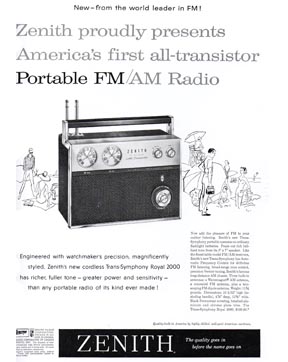 The build quality is equal to that of the solid state Trans-Oceanics. The radio is slightly larger than the 1000 and 3000 Trans-Oceanics. The chassis mounts upside down at the top of the cabinet to give plenty of space for the 5x7 speaker and ample acoustic space for good sound.
The build quality is equal to that of the solid state Trans-Oceanics. The radio is slightly larger than the 1000 and 3000 Trans-Oceanics. The chassis mounts upside down at the top of the cabinet to give plenty of space for the 5x7 speaker and ample acoustic space for good sound.
Like the 1000 and 3000 Trans-Oceanics, the chromed side pieces are subject to pitting, unfortunately, and the soft aluminum control panel is easily dented, especially along the upper front edge. The lower front section covering the speaker is also aluminum, usually painted black.
The two circular dials, one for FM and one for AM, move in parallel. The on/off/volume control knob is in the middle of the tuning knob. The knobs at the upper right on the control panel are for band selection and tone control. The front control panel had a lacquer applied which has often yellowed over the years. Inside on the rear chassis apron is an FM out RCA 1/4" phono jack so that the FM signal can be sent to the auxilliary input of an amplifier and speaker system. Next to it is a 1/8" mono earphone jack.
AM performance is excellent, and compares to the Trans-Oceanics on the broadcast band. FM performance is also very good. The FM section is tuned by three permeably tuned oscillators, normally found only on more expensive ham radio gear. The Zenith 2000 is an eleven transistor radio. Care must be taken when working on the chassis to avoid damaging the FM tuning mechanism. Recapping the Zenith 2000 is not a job for the novice. About half of the electroytic capacitors are buried under other components. Getting them out is actually more difficult than soldering in new replacements.

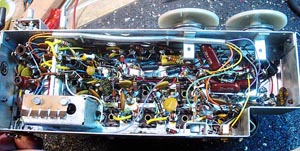 I found my radio at a hamfest for $30. It played on both bands, but at very low volume. A recap took care of that, and the radio now plays with great audio and good sensitivity on both bands. The challenge was restoring the cabinet, which was actually in fairly good condition, except for the pitted chrome and front control panel, which had very yellowed lacquer and numerous scratches, along with some small dents, typical of these radios.
I found my radio at a hamfest for $30. It played on both bands, but at very low volume. A recap took care of that, and the radio now plays with great audio and good sensitivity on both bands. The challenge was restoring the cabinet, which was actually in fairly good condition, except for the pitted chrome and front control panel, which had very yellowed lacquer and numerous scratches, along with some small dents, typical of these radios.

I completely disassembled the radio cabinet and cleaned the cabinet with Simple Green. I repainted the black speaker grille. I tried to remove the aluminum control panel to work on it off the the cabinet. Don't attempt to remove the panel. I found that the panel is attached to the cabinet with some kind of adhesive along the top. This became apparent when the upper part began to bend. Luckily I was able to use a piece of flat hardwood along the top to tap the soft aluminum top section flat again. First I tried cleaning the control panel with 0000 steel wool and while vinegar. This removed most of the yellowed lacquer. I had to be very gentle around the lettering so as to not remove it. While it was much better than before, I still didn't like the looks, so I ended up using the steel wool and vinegar to remove all the remaining lacquer and lettering on the front.
I made a set of decals from photographs I made of the lettering before I removed it. I printed the decals on Testors inkjet decal paper. I first coated the aluminum front with several coats of clear lacquer. After it dried for 24 hours, I applied the decals. I let the decals dry for a day, then applied more coats of lacquer. While the results were acceptable, it is virtually impossible to make the decal edges disappear on unpainted metal, so up close the decal edges can be seen. I used a small pointed brush to handpaint the embossed Zenith logo.
This historically important radio is well worth collecting and restoring. An excellent sounding and performing radio, it is a great radio for the deck, kitchen, workshop or camping. It's not quite as heavy as the solid state Trans-Oceanics, but not by much, especially with eight D cells installed. In 1964, the 2000-1 model was introduced, which featured a jack for a 12-volt AC adapter. The Zenith Royal 2000 Trans-Symphony was discontinued around 1966.
Zenith 500 Transistor AM Radios
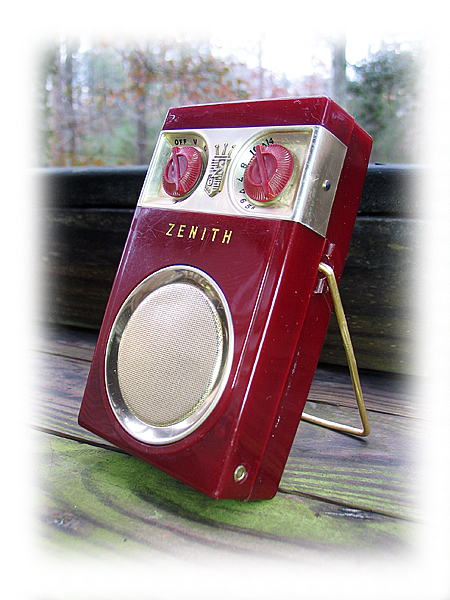 1955 Zenith 500, 7XT40 Hand-Wired Chassis
1955 Zenith 500, 7XT40 Hand-Wired Chassis
In November, 1955, Zenith released the Zenith 500 transistor radio, the first in a long line of 500 coat-pocket sized radios that lasted until 1964, ending with the model 500H. Shown at right is an example of a very early 500 in a translucent maroon case. Somewhere around serial number 18000, Zenith switched to a darker, solid maroon case. The radio was also available in black.
The serial number of this radio is 138xx, and it appears to have been assembled sometime in the 4th week of 1956. The chassis in this radio is a 7XT40, circuit #1, with Sylvania transistors. This example has a well-worn case, with quite a few scratches and a chip out of one bottom corner, and the battery compartment showed signs of leakage. I was able to purchase it at a reasonable price given its flaws.
The circuit of the original 500 was changed several times in the first few months to improve performance, and by late 1956 or early 1957, Zenith began producing the 500 with printed circuit boards instead of hand-wired circuits, and added an eigth transistor to improve RF reception. From its inception, however, the 500 was an excellent performing radio and set the bar for other manufacturers.
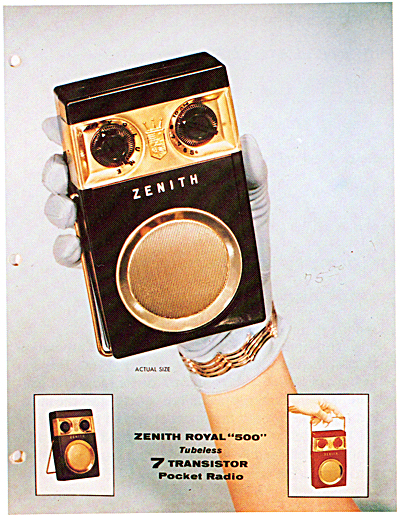 Inside, the radio was all original. Batteries had leaked at some time, and the battery terminals were corroded. I cleaned away the corrosion and installed four new electrolytic caps. I wanted to re-stuff the original capacitors to maintain its original appearance, but the plastic capacitor bodies were brittle and broke like egg shells when I tried to drill them out. Once the radio was recapped and a broken antenna lead resoldered, it played.
Inside, the radio was all original. Batteries had leaked at some time, and the battery terminals were corroded. I cleaned away the corrosion and installed four new electrolytic caps. I wanted to re-stuff the original capacitors to maintain its original appearance, but the plastic capacitor bodies were brittle and broke like egg shells when I tried to drill them out. Once the radio was recapped and a broken antenna lead resoldered, it played.
I cleaned the plastic case with Novus and tried to removed some of the scratches, but not much helped. The brass was cleaned with Brasso. I didn't get too aggressive around the dial numbering as it comes off easily. It doesn't look too bad, and it plays well.

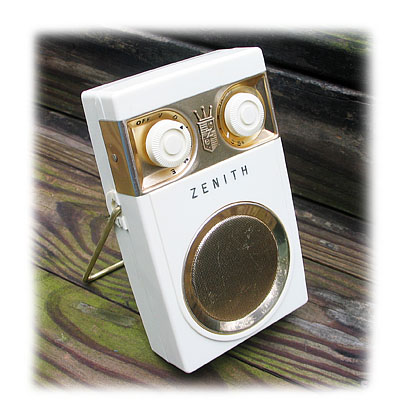
1956 Zenith 500B Chassis 7ZT40Z1 Printed Circuit Board
Zenith modified the original hand-wired 500 at least three times between the first production in late 1955 and the introduction of the 500B in late 1956. The 500B (the B is not an official Zenith Model designation) introduced Zenith's first use of a printed circuit board in the 500 series. This radio has chassis 7ZT40Z1, s/n 1135xx, which is about 100,000 units after the 500 shown above. This makes it a very early example of the 500B series. Chassis 7ZT40Z1 uses seven Texas Instruments transistors. There is a production date of November, 1956, on the tuning capacitor. It also has vernier tuning and thicker knobs, a big improvement over the original 500.
Restoration was very straightforward; these are simple radios to work on for the most part. I replaced the four electrolytic capacitors, two 50uF and two 3uF, with two 47uF and two 3.3uF caps. I lubricated the tuning mechanism, and squirted some contact cleaner into the volume control. It was still scratchy and intermittent if touched. I then tried DeOxit, which improved the scratchiness, but the control is still sensitive to touch.
The case is in very good condition, although the lettering on the back of the radio has worn away for the most part. I completely stripped the case and washed it in warm water and Dawn. It was then buffed and polished with Novus #2 and #1. The knobs were also washed in warm soapy water, then got a treatment in a glass of denture cleaner for an hour or so. They came out looking like new. The brass was cleaned and polished as well, then I reassembled the radio as shown at left.

1957 Zenith 500RD Transistor AM Radio
Introduced in late 1957, the eight transistor model 500RD replaced the original hand-wired, seven transistor 500 series radios introduced in 1955. The 500RD preceded the later 500D models released later in 1958.
The 500D had "500D" imprinted below the Zenith crest, and used chassis 8AT40Z2. The later model also used a newly designed convex speaker to improve tonal range.
In 1957 Zenith begain using a printed circuit board in the 500 series. The Zenith 500RD and 500D series radios were high performance radios and hold their own even today.
I purchased this model in untested condition as the battery compartment was so corroded from battery leakage I had to make new battery terminals in order to test it. I also replaced the electrolytic caps in the radio while I had it disassembled.
The body turned out to be in pretty nice condition after a thorough cleaning with soap and water and buffing and polishing with Novus. The brass was restored with Brasso. The serial number on this radio is 5777xx and the build date is in June, 1958.
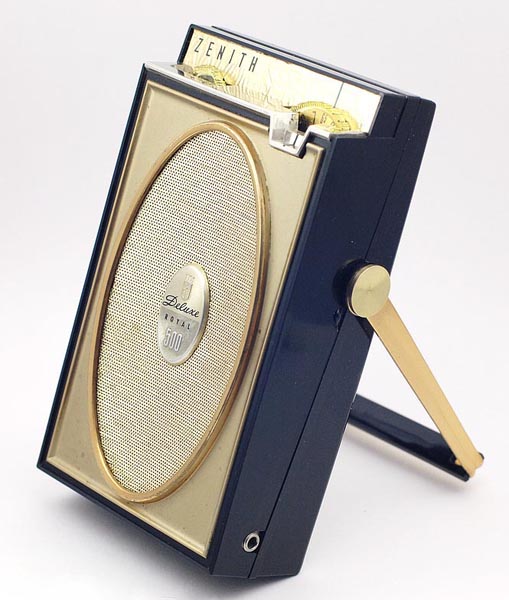
1961-64 Zenith 500 Model H Deluxe 8 Transistor Pocket Radio
In 1961, Zenith completely redesigned the Zenith 500 for a new, modern look, fantastic audio for a pocket radio, and improved performance. The Model H, offered from 1961 to 1964, is considered to be the best pocket radio ever produced by Zenith, and is highly sought after by collectors. I found this one in an antique store, in excellent condition, both cosmetically and electronically. It plays so well I have done nothing to it other than clean up the case and replace the foil strip above the dials with a reproduction foil strip.
 To obtain the awesome audio of the 500H, Zenith designed a completely new and unique oval speaker measuring 3" by 5". The magnet and coil were offset, and the amplifier output was increased from 100mW in the earlier 500's to 350mW in the 500H. In addition, the cabinet was acoustically designed to enhance the sound of the speaker.
To obtain the awesome audio of the 500H, Zenith designed a completely new and unique oval speaker measuring 3" by 5". The magnet and coil were offset, and the amplifier output was increased from 100mW in the earlier 500's to 350mW in the 500H. In addition, the cabinet was acoustically designed to enhance the sound of the speaker.
The radio sold for $60, which was $15 cheaper than the earlier models. The lowered price was necessitated by the increasing competition from Japanese and other Asian made imports that were good performers at half the price of the Zenith. Zenith most likely did not make much profit on the 500H.
One weakness of the 500H radios was the foil strip above the dials with the Zenith brand. These delaminate over time, and getting them glued back in place can be difficult as the bottom of the strip fits down into narrow slots behind the knobs. When attempting to re-glue the label, the label often sticks before it can be properly position. I ended up ruining my original strip trying to reglue it.
Fortunately, a reproduction is available online from Radiolaguy, and I was able to replace the damaged strip with the reproduction, so now the radio looks almost brand new. This is an excellent performing radio just as found, pulling in stations both near and far across the dial. Sound is amazing for a radio this size. At some point, it will be necessary to replace the capacitors in the radio, but for now it works quite well.

 Click the YouTube logo to see and hear Zenith 500's.
Click the YouTube logo to see and hear Zenith 500's.
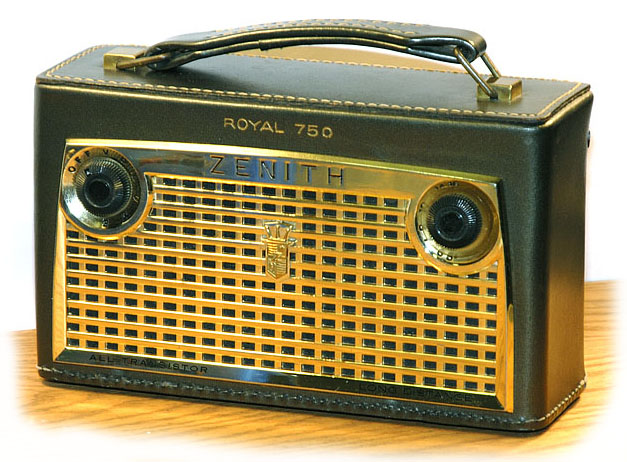
1957 Zenith 750 Transistor AM Radio
Introduced in 1957, the model 750 was a very high performance 8 transistor radio with exceptional sensitivity and strong audio. It has a tuned RF amplifier and three-gang tuning condenser. It featured a 4" speaker and used six C cells, and a set of modern alkaline cells will power the radio for hundreds of hours. I found this radio at a local antique mall. The owner's name and address were inside the radio, and a search revealed that his estate had been auctioned off just several weeks before I found this radio at the antique mall.

The radio is shown as found and it is not only in excellent cosmetic condition, but this 54 year old radio plays perfectly. The leather and stitching are near perfect, and the gold grill on the front has minimal wear. Most of these radios were tan or black; the green leather is much less commonly found.
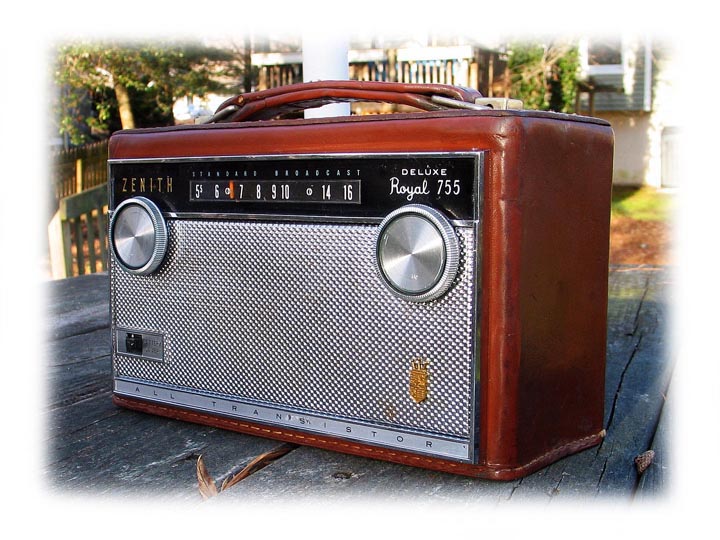
1959 Zenith Deluxe 755G AM Radio
1962 Zenith Deluxe 755LK AM Radio
In 1959, Zenith gave the Model 750 a make-over and rebadged it as the Model 755. Several versions of the Model 755 can be found, and the one at right is the 755LK, which may be the last in the series. The 755 features a slide rule dial. Some early 755's had the antenna in the handle, which could be rotated for best reception, but Zenith found reception was better with the loop inside the radio, and the rigid handle was replaced with the strap as shown in this early model 755G, below, left.
The 755G has a near mint leather case, with just one minor scuff near the top right front. Volume was a little weak and sensitivity off, so I recapped this radio. Note that it also lacks the battery saver switch at the lower left front, a feature found on the later 755LK as well as the 790YK shown further below.
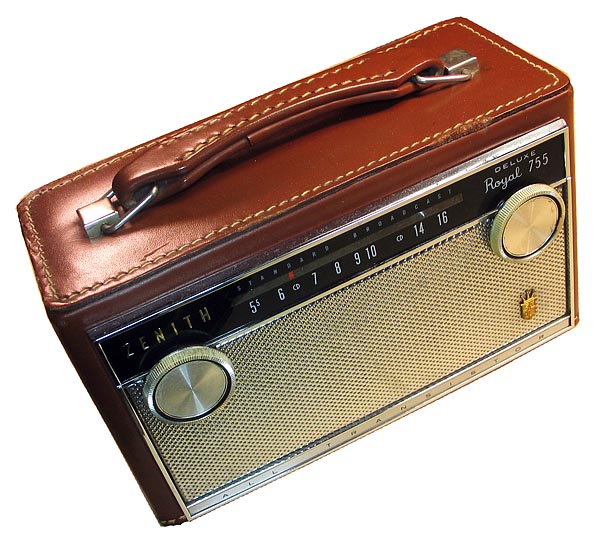 The 755 has excellent AM reception. The receiver is quite senstive, and the audio quality is very good. Both radios came, as did the 790YK below, without battery holders, so I just soldered in a 9-volt snap connector and used a 9-volt cell for power. It is lighter and less expensive than six C cells.
The 755 has excellent AM reception. The receiver is quite senstive, and the audio quality is very good. Both radios came, as did the 790YK below, without battery holders, so I just soldered in a 9-volt snap connector and used a 9-volt cell for power. It is lighter and less expensive than six C cells.
I did not recap the 755LK, as it still performs superbly with the original caps. I had to do a lot of clean-up on the leather case, which is otherwise in excellent condition, with no tears and all the stitching intact. This radio would outperform most AM radios on the market today. This version of the 755 features the battery saver switch, which, of course, can't be used with a 9-volt cell.
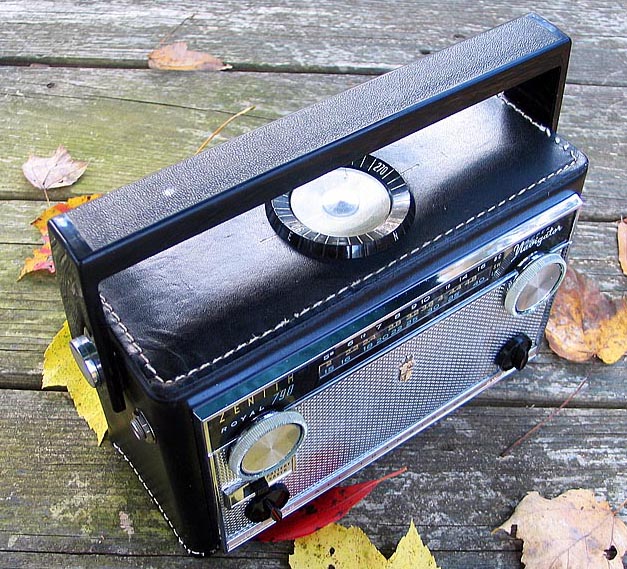
1962 Zenith 790YK Super Navigator
The Zenith line of Navigator radios were targeted to boaters and aviators. The radios contained a switch that shut off the AGC circuit to make the radio super-sensitive to the direction of a radio signal, and in the navigate mode, the radio could be used as a radio direction finder. By beaming in on a known radio station, a boater or pilot could follow the signal to find their way to shore or an airport if they became lost or other navigation equipment failed.
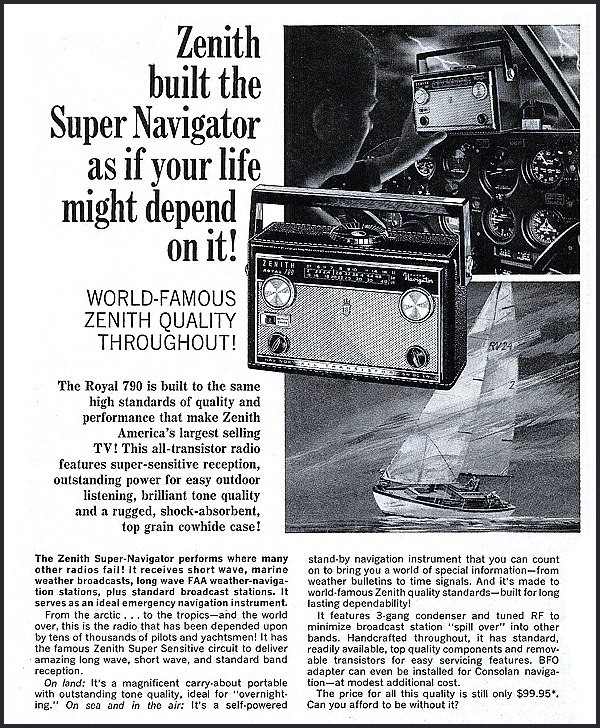 The radios were excellent performers, with the eight transistor version having an RF amplifier. On the broadcast band, the radio will pull in AM stations much better than most radios, even better than many AM radios on the market today. The radio also includes the longwave (LW) band, now abandoned except for navigation buoys near the coast, but in 1962 would have broadcast marine and aviation weather reports. Shortwave reception from 2.2 MHz to 4.8MHz was also provided, which at the time also provided the boater or aviator with marine coverage along with time, weather, and amateur radio broadcasts.
The radios were excellent performers, with the eight transistor version having an RF amplifier. On the broadcast band, the radio will pull in AM stations much better than most radios, even better than many AM radios on the market today. The radio also includes the longwave (LW) band, now abandoned except for navigation buoys near the coast, but in 1962 would have broadcast marine and aviation weather reports. Shortwave reception from 2.2 MHz to 4.8MHz was also provided, which at the time also provided the boater or aviator with marine coverage along with time, weather, and amateur radio broadcasts.
I found this radio on eBay. It was lacking the battery holders for the six C cells required to power it, so the seller was offering it untested. The radio was in need of a good cleaning and had the expected scuffs and scratches of a well used radio. I was able to win the radio for the opening bid of $9.95, so I was pretty happy.
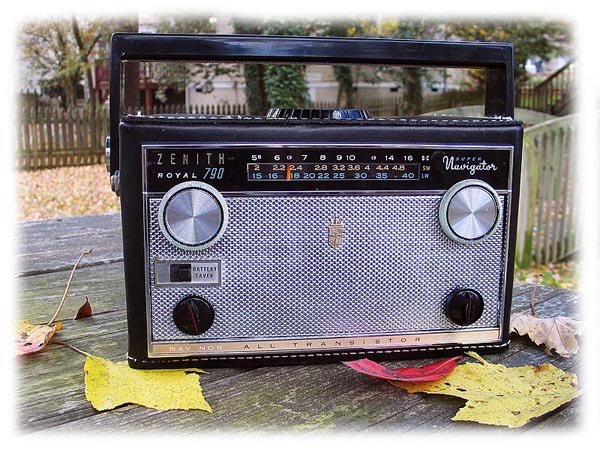 For power, I tacked in a 9-volt snap connector, which provides the same power as the six C cell would, with a lot less weight, and cheaper. No sound of any kind could be heard at the speaker when I applied power, and I thought the radio was dead. I connected earphones to the external earphone jack, and still got no sound. I then found an earphone jack inside the radio on the chassis. I plugged in earphones and got nice sound and reception. Earphone jacks on vintage transistor radios are a common trouble spot. They contain a tiny switch that passes audio to the speaker, and they often becomed oxidized or damaged and the circuit to the speaker is broken.
For power, I tacked in a 9-volt snap connector, which provides the same power as the six C cell would, with a lot less weight, and cheaper. No sound of any kind could be heard at the speaker when I applied power, and I thought the radio was dead. I connected earphones to the external earphone jack, and still got no sound. I then found an earphone jack inside the radio on the chassis. I plugged in earphones and got nice sound and reception. Earphone jacks on vintage transistor radios are a common trouble spot. They contain a tiny switch that passes audio to the speaker, and they often becomed oxidized or damaged and the circuit to the speaker is broken.
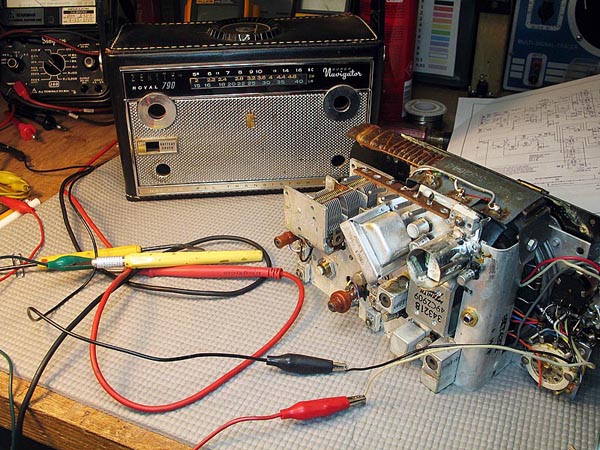 Because the jack was mounted on the chassis, it was necessary to removed the chassis and the speaker. The radio has a rugged chassis, with socketed transistors like those used on the solid state Trans-Oceanics. While the chassis was disassembled, I replaced all the electrolytic capacitors. I cleaned the earphone jack, and the radio played like new.
Because the jack was mounted on the chassis, it was necessary to removed the chassis and the speaker. The radio has a rugged chassis, with socketed transistors like those used on the solid state Trans-Oceanics. While the chassis was disassembled, I replaced all the electrolytic capacitors. I cleaned the earphone jack, and the radio played like new.
I cleaned the knobs, case and front chromed grille, and re-assembled the radio. It is a superb performer on the AM band, and will receive AM stations from hundreds of miles away. It is also an excellent short waver receiver.
Want to hear it play? Click here!

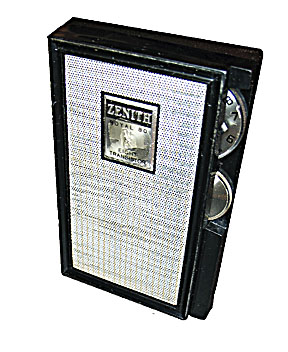
1965 Zenith 80Y Transistor AM radio
I found this post-1965 Zenith Royal 80Y AM eight-transistor radio in the same antique store as the Zenith 750 above. The cosmetic condition is poor, but the radio plays quite well except for a flaky volume control, a common problem with these old transistor radios. The pots wear out and they are almost impossible to replace. I was tempted to buy this radio because it still had a sticker on the back touting the cost advantage of using AA which were becoming more and more popular, especially since the advent of alkaline cells.
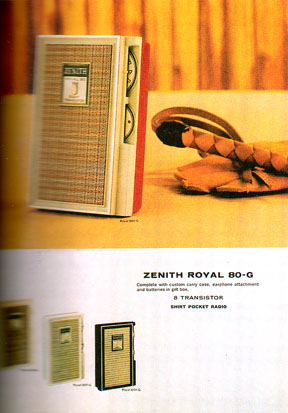

The only repair I had to make to this radio was to construct a new battery terminal for one of the AA cells. The model 80 was first issued in 1965 as the model 80G. I'm not sure what year the 80Y was released, but the 80 series transistors were developed to compete with the Japanese imports that were taking over the market. It used some imported parts and integrated circuits to keep productions costs low. However, it was still a well designed radio and performed as Zenith radios were expected to.

1965 Zenith Hearing Aid
These are often mistakenly listed on eBay as transistor radios by GenX and Millenial sellers who have never seen a hearing aid that doesn't fit inside the ear. Zenith manufactured many styles of hearing aids over the years. The example shown here actually has three tiny tubes inside. These were replaced with transistors in the mid-1950's.
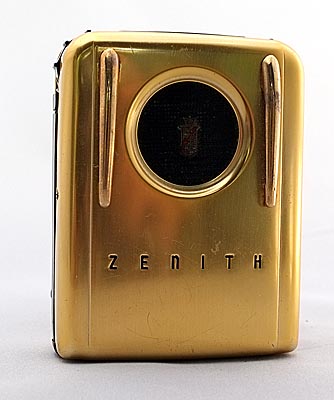



 The build quality is equal to that of the solid state Trans-Oceanics. The radio is slightly larger than the 1000 and 3000 Trans-Oceanics. The chassis mounts upside down at the top of the cabinet to give plenty of space for the 5x7 speaker and ample acoustic space for good sound.
The build quality is equal to that of the solid state Trans-Oceanics. The radio is slightly larger than the 1000 and 3000 Trans-Oceanics. The chassis mounts upside down at the top of the cabinet to give plenty of space for the 5x7 speaker and ample acoustic space for good sound.

 1968 Zenith Royal 73 Transistor Radio
1968 Zenith Royal 73 Transistor Radio Zenith Royal 2000 Trans-Symphony AM/FM Portable Radio
Zenith Royal 2000 Trans-Symphony AM/FM Portable Radio
 I found my radio at a hamfest for $30. It played on both bands, but at very low volume. A recap took care of that, and the radio now plays with great audio and good sensitivity on both bands. The challenge was restoring the cabinet, which was actually in fairly good condition, except for the pitted chrome and front control panel, which had very yellowed lacquer and numerous scratches, along with some small dents, typical of these radios.
I found my radio at a hamfest for $30. It played on both bands, but at very low volume. A recap took care of that, and the radio now plays with great audio and good sensitivity on both bands. The challenge was restoring the cabinet, which was actually in fairly good condition, except for the pitted chrome and front control panel, which had very yellowed lacquer and numerous scratches, along with some small dents, typical of these radios.
 1955 Zenith 500, 7XT40 Hand-Wired Chassis
1955 Zenith 500, 7XT40 Hand-Wired Chassis Inside, the radio was all original. Batteries had leaked at some time, and the battery terminals were corroded. I cleaned away the corrosion and installed four new electrolytic caps. I wanted to re-stuff the original capacitors to maintain its original appearance, but the plastic capacitor bodies were brittle and broke like egg shells when I tried to drill them out. Once the radio was recapped and a broken antenna lead resoldered, it played.
Inside, the radio was all original. Batteries had leaked at some time, and the battery terminals were corroded. I cleaned away the corrosion and installed four new electrolytic caps. I wanted to re-stuff the original capacitors to maintain its original appearance, but the plastic capacitor bodies were brittle and broke like egg shells when I tried to drill them out. Once the radio was recapped and a broken antenna lead resoldered, it played.



 To obtain the awesome audio of the 500H, Zenith designed a completely new and unique oval speaker measuring 3" by 5". The magnet and coil were offset, and the amplifier output was increased from 100mW in the earlier 500's to 350mW in the 500H. In addition, the cabinet was acoustically designed to enhance the sound of the speaker.
To obtain the awesome audio of the 500H, Zenith designed a completely new and unique oval speaker measuring 3" by 5". The magnet and coil were offset, and the amplifier output was increased from 100mW in the earlier 500's to 350mW in the 500H. In addition, the cabinet was acoustically designed to enhance the sound of the speaker.



 The 755 has excellent AM reception. The receiver is quite senstive, and the audio quality is very good. Both radios came, as did the 790YK below, without battery holders, so I just soldered in a 9-volt snap connector and used a 9-volt cell for power. It is lighter and less expensive than six C cells.
The 755 has excellent AM reception. The receiver is quite senstive, and the audio quality is very good. Both radios came, as did the 790YK below, without battery holders, so I just soldered in a 9-volt snap connector and used a 9-volt cell for power. It is lighter and less expensive than six C cells. 
 The radios were excellent performers, with the eight transistor version having an RF amplifier. On the broadcast band, the radio will pull in AM stations much better than most radios, even better than many AM radios on the market today. The radio also includes the longwave (LW) band, now abandoned except for navigation buoys near the coast, but in 1962 would have broadcast marine and aviation weather reports. Shortwave reception from 2.2 MHz to 4.8MHz was also provided, which at the time also provided the boater or aviator with marine coverage along with time, weather, and amateur radio broadcasts.
The radios were excellent performers, with the eight transistor version having an RF amplifier. On the broadcast band, the radio will pull in AM stations much better than most radios, even better than many AM radios on the market today. The radio also includes the longwave (LW) band, now abandoned except for navigation buoys near the coast, but in 1962 would have broadcast marine and aviation weather reports. Shortwave reception from 2.2 MHz to 4.8MHz was also provided, which at the time also provided the boater or aviator with marine coverage along with time, weather, and amateur radio broadcasts. For power, I tacked in a 9-volt snap connector, which provides the same power as the six C cell would, with a lot less weight, and cheaper. No sound of any kind could be heard at the speaker when I applied power, and I thought the radio was dead. I connected earphones to the external earphone jack, and still got no sound. I then found an earphone jack inside the radio on the chassis. I plugged in earphones and got nice sound and reception. Earphone jacks on vintage transistor radios are a common trouble spot. They contain a tiny switch that passes audio to the speaker, and they often becomed oxidized or damaged and the circuit to the speaker is broken.
For power, I tacked in a 9-volt snap connector, which provides the same power as the six C cell would, with a lot less weight, and cheaper. No sound of any kind could be heard at the speaker when I applied power, and I thought the radio was dead. I connected earphones to the external earphone jack, and still got no sound. I then found an earphone jack inside the radio on the chassis. I plugged in earphones and got nice sound and reception. Earphone jacks on vintage transistor radios are a common trouble spot. They contain a tiny switch that passes audio to the speaker, and they often becomed oxidized or damaged and the circuit to the speaker is broken. Because the jack was mounted on the chassis, it was necessary to removed the chassis and the speaker. The radio has a rugged chassis, with socketed transistors like those used on the solid state Trans-Oceanics. While the chassis was disassembled, I replaced all the electrolytic capacitors. I cleaned the earphone jack, and the radio played like new.
Because the jack was mounted on the chassis, it was necessary to removed the chassis and the speaker. The radio has a rugged chassis, with socketed transistors like those used on the solid state Trans-Oceanics. While the chassis was disassembled, I replaced all the electrolytic capacitors. I cleaned the earphone jack, and the radio played like new.




